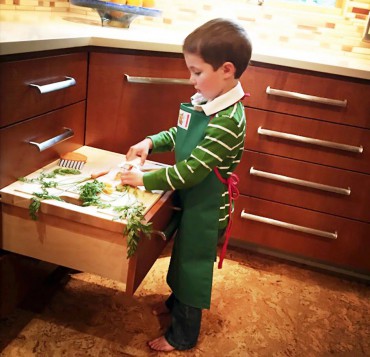 It’s that time of year when farmers markets are in full swing, offering up a full complement of healthy, locally grown foods. Are you getting your recommended daily allowance of nutrients? What about your kids?
It’s that time of year when farmers markets are in full swing, offering up a full complement of healthy, locally grown foods. Are you getting your recommended daily allowance of nutrients? What about your kids?
Instilling good eating habits in our children is easier said than done, as evidenced by the number of overweight children in America today. According to the American Obesity Association, 35 percent of children ages 6-11 are overweight and 18 percent are actually obese.
Many people assume that because I am a devoted foodie and accomplished cook, my children are accomplished eaters. Nothing could be farther from the truth. Needless to say, they tolerate my “healthy ways” and if left to their own devises, my children will eat macaroni-and-cheese from a box.
However, I have not given up hope and neither should you. Here are some helpful hints on how to achieve gastronomic harmony in your house while improving your child’s eating habits:
Involve your children in the process.
Buy or borrow from the library cookbooks that are geared toward children. Two good choices for the under-10 crowd would be “Pretend Soup” by Mollie Katzen or “One Bite Won’t Kill You” by Ann Hodgman.
Experiment with new foods by letting your children choose a recipe each week. In my experience, when the child actually makes the food choice, he or she is more likely to consume it.
Help your children understand where their food comes from by including them on food buying trips.
When my children were little, I would take them to our CSA (community supported agriculture) Butler Greens, an organic farm on Bainbridge Island run by Brian MacWhorter. They loved to help pick out the bounty of each season.
We have also gone to the Suyematu Farm to buy fresh strawberries and raspberries in summer and jack ‘o lanterns and sugar pumpkins in the fall. We freeze these items for enjoyment all winter long.
Trips to traditional grocery stores can be many lessons rolled into one: counting, weighing, budgeting and sustainable agriculture.
My son loves plums more than any other fruit in the world but he learned to refrain from asking for them during the winter months because they are grown in countries where herbicide/pesticide use is high (to say nothing of the price). Now he identifies the country of origin before making a bid for a purchase.
Try not to give in to pleas for “licensed” junk foods such as “Star Wars” fruit snacks.
Invite your children to help in the kitchen.
Parents frequently tell me that they just can’t cope with the mess their children make in the kitchen. Cooking with kids can be a messy process. OK, a very messy process.

I remember the time when my son, then 3 years old, turned on the stand mixer before I had a chance to raise the bowl up. “Mommy, it’s snowing,” I heard him say, as flour was swirling all around him and the machine. Oh well; experiences like this make for great family stories, but messes can be minimized with a little foresight and the right tools.
There are a wonderful variety of kitchen tools (notice I did not say gadgets) that are designed with messy cooks in mind.
Some of my current favorites include: the apron and oven mitt kit from Burn Guard (it not only keeps kids clean but safe from hot stuff as well — our pint-sized chef is modeling the apron); the Taxi Prep, a 5-inch-wide, stainless steel dust pan for scooping up chopped items and depositing them in a bowl/pan (this tool is a real confidence builder as it prevents items from accidentally dropping to the floor); and a horizontal grater with a nonslip-bottomed catch container.
Tools aside, the most import thing is having your child sitting or standing at a level that makes kitchen work achievable and safe.
Be realistic.
For me, food is not just a job, it is a passion. However, I don’t expect my children to salivate at the idea of butternut squash soup with chipotle cream for dinner.
On the other hand, as a working mother, my days of being a short-order cook are over. I will confess that I have spent far too many nights making four separate meals for my family.
I don’t eat meat and poultry. My daughter did not like fish for several years and neither of my children would eat broccoli. You get the picture. For anyone caught in the short-order mode, I recommend you tell your family that the Smith Family Diner is permanently closed.
So where is the happy medium, the holy food grail? Trust me, it does exist — somewhere between the macaroni-and — and the chipotle cream.
You can begin by serving the same foods, just differently. Marinate grilled chicken to your taste and simply salt-and-pepper the kid’s pieces. Give the kids the choice of eating their broccoli raw with ranch dressing while you eat yours steamed. Put sauces on the side so your kids can try them by “dipping” while adults have their sauce placed directly on the food.
If all else fails, enlist the help of your medical professional. Ever notice how kids will listen more intently to their pediatrician than they will to their parents?
Our pediatrician helped our children set some basic food guidelines that we could all live with. They are:
- Each meal will consist of a protein and either a fruit or vegetable (sometimes my son would request carrots for breakfast).
- Proteins and fruits/vegetables are to be eaten before carbohydrates.
- Reserve sweets and treats for weekends (recognize you’ll need to make allowances for school celebrations). It may help to put a copy of the food pyramid on your refrigerator as a guide.
Lastly, arrange your pantry and refrigerator so that healthy snacks can be easily accessed by children and they can make healthy choices without your assistance.
Reprinted with permission from Sound Publishing
































Comments